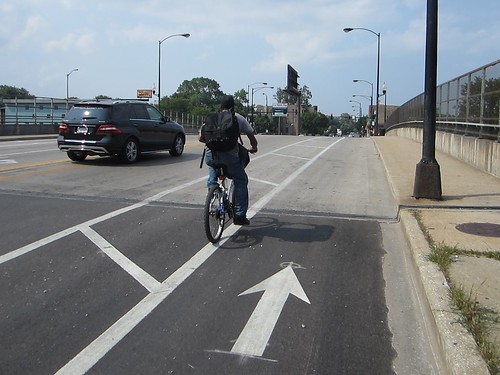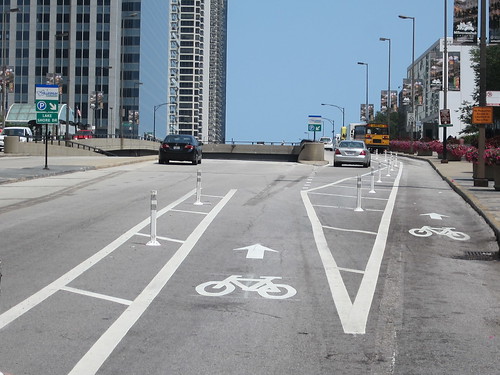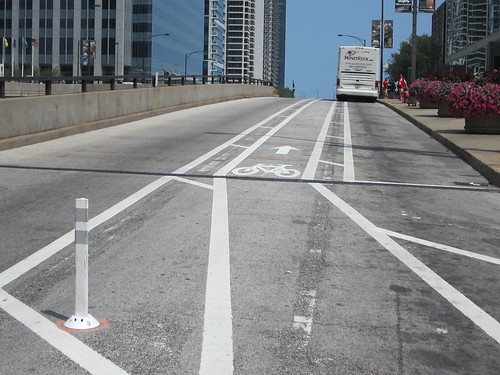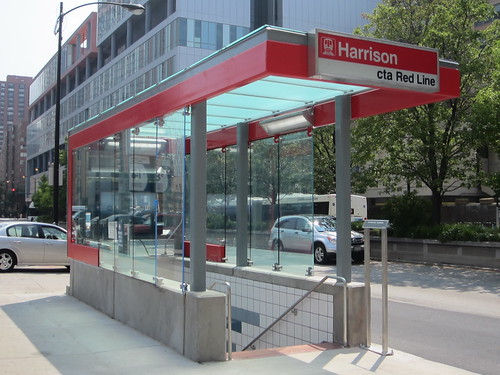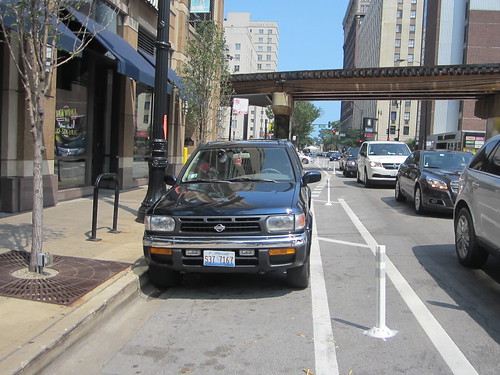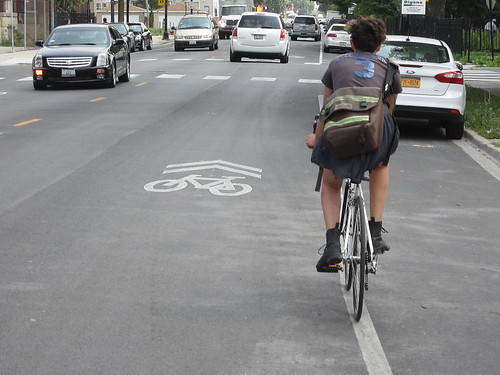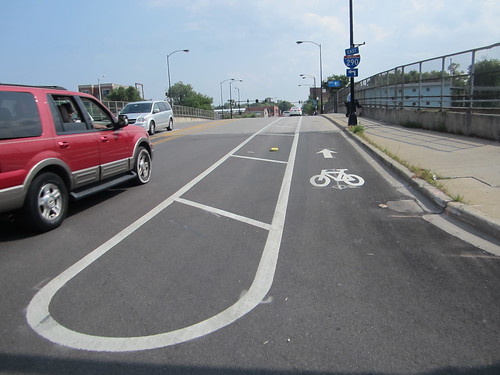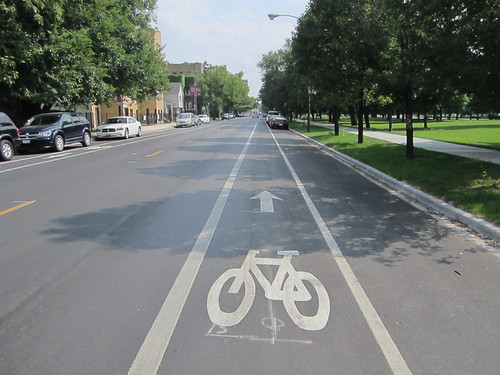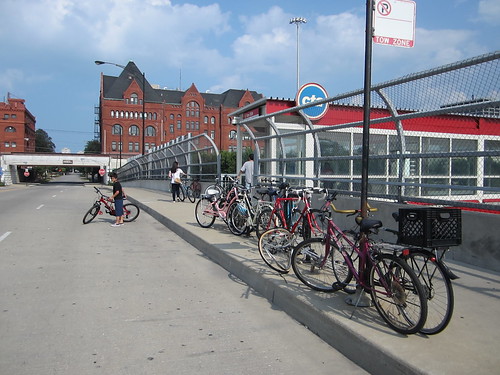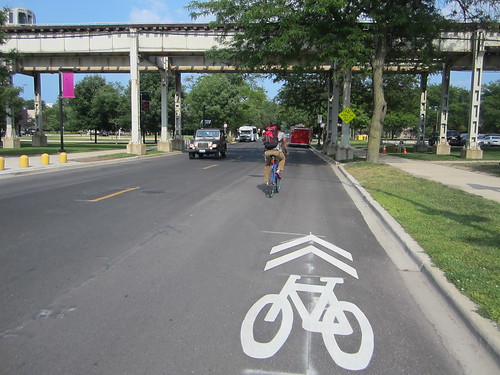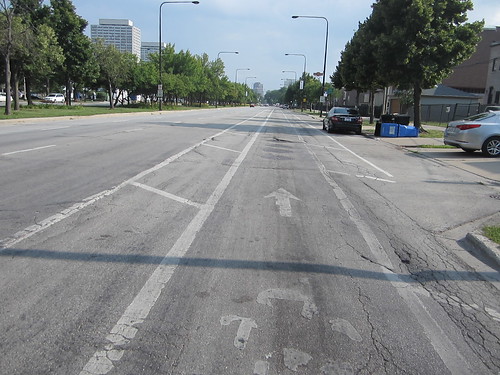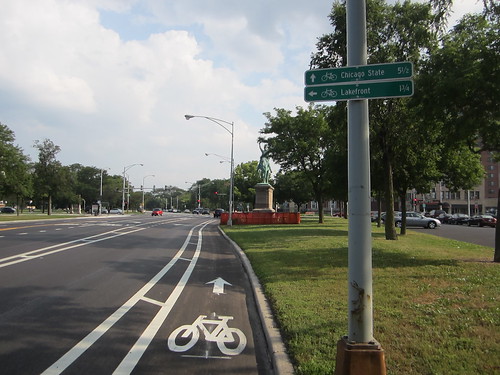Chicago Department of Transportation crews are continuing their work this summer, building new bikeways and upgrading existing ones. Yesterday, I took a spin around the Loop and the South Side to check out the latest improvements on Randolph, Harrison, California, 33rd, and King.
I started out on Upper Randolph, where CDOT recently upgraded the existing conventional lane between Michigan and the Millennium Park bike station to a buffered lane, and added a short stretch of buffered lane to shepherd riders onto Lower Randolph. When I checked this out earlier this month, tour buses were still using the stretch of the bike lane near Michigan, where the lane is curbside, as a standing zone.
However, flexible plastic posts have since been added, which seem to be doing a good job of keeping buses out of the lane. Drivers don’t seem to be having any problems navigating the slightly complex road layout. Further up the hill, the bike lane shifts to the left of a parking lane, so the buses only partially block the bikeway.
Next, I checked in on the new protected lanes on Harrison from Wabash to Desplaines. Since the last time I looked at it, CDOT has added flexible posts. With generally good pavement quality, plenty of green paint, and now posts, Harrison now joins Dearborn, Milwaukee and Elston as being one of Chicago’s nicest PBLs.
As I cruised the Harrison lanes, I checked out two new main entrance canopies for the Harrison Red Line station, part of a $10 million station overhaul. These classy glass structures feature large video screens that display ads and train arrival times.
The main fly in the ointment with the Harrison PBLs is that drivers are parking in them, since the lanes are generally curbside with no parking lane to their left. Although new “No Parking” signs have been added since my last visit, I saw a number of vehicles in the lanes, including a U.S. Postal Service truck near the main post office. Perhaps adding posts to the entrances of the lanes at intersections would solve this problem.
Next, I headed west to California Avenue, where CDOT has installed brand new bikeway markings, mostly a mix of sharrows and conventional bike lanes, between Madison and Roosevelt. This treatment feels like a bit of a throwback, since the city has pretty much stopped striping new conventional lanes. Instead, new bikeway streets generally at least get buffered lanes, if not protected ones, as part of the quest to reach 100 miles of advanced lanes by 2015. However, this stretch of California is generally about 42 feet wide, so a parking lane would need to be removed to make room for buffered lanes.
Although BBLs would have been preferable, silky-smooth new asphalt and the new bike markings have transformed this section into a good street for biking. I saw a half dozen cyclists on it within a few minutes. One nice touch is a short section of bike lane with a very wide buffer where California crosses the Eisenhower Expressway. Flexible posts to keep cars out of the lane would be a good addition.
From Roosevelt to 19th, where California borders Douglas Park, the pavement has also been replaced and the existing conventional lanes have been restriped. This stretch is about 44 feet wide, but it’s still too narrow for buffered lanes without removing parking, and the spaces near the park are heavily used.
The city’s bike map indicates that there are conventional lanes on California south of 19th, where the street runs through a bustling Little Village business district but in reality these are virtually invisible “zombie lanes,” long overdue for restriping. This will surely happen when this section is repaved.
From there, I headed to 33rd Street, where new asphalt and shared-lane markings were added from State to King as part of a water department project. On the way, I passed by the north entrance of the Red Line’s Sox/35th station, near the IIT campus. Although there are only two “inverted U” bike racks here, about a dozen bikes are locked up to various objects here, so more racks are clearly needed.
After enjoying the satiny new pavement on 33rd, a mellow route to the lakefront, I headed south on King to check out the recently refreshed asphalt on the drive from 37th to 51st. Although King is one of Chicago’s oldest bike lane streets, it’s never been a particularly bike-friendly route due to multiple lanes of high-speed traffic. Even after travel lanes on the King were converted to very wide buffered lanes in Bronzeville a couple years ago, rough pavement still made for a fairly unpleasant riding experience.
The fresh pavement and markings make a world of difference on this new stretch. Although you still need to contend with two lanes of fast traffic in each direction, the smooth, highly visible lanes now make this a decent cycling route.
The new lanes end a stone’s throw from 51st and Calumet, which is turning into a biking hotspot thanks to youth bike programs and free repair sessions at the Bronzeville Community Garden, as well as the brand new Bronzeville Bike Box pop-up bike shop. We’ll have an update on the shop, housed in a recycled shipping container, next week.
